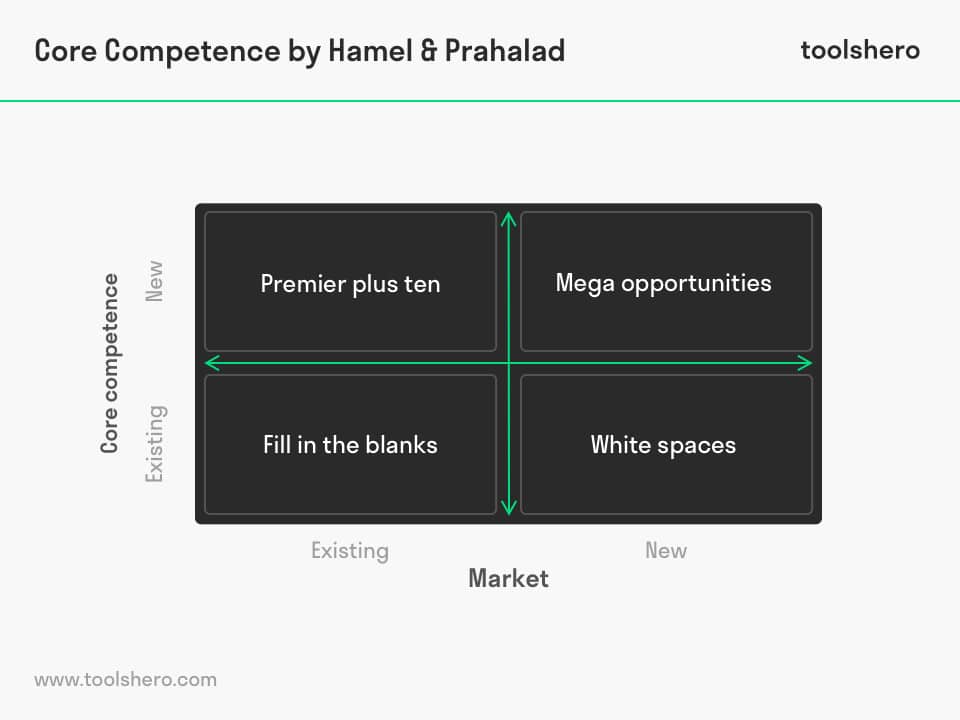Core Competence Model (Hamel and Prahalad)

Core Competence Model: this article explains the Core Competence Model, developed by Gary Hamel and C. K. Prahalad in a practical way. After reading you will understand the basics of this powerful strategic management and competitive advantage tool.
What is the Core Competence Model?
It is important for organizations to focus on their competences and draw their strengths from this when they want to get ahead of their competition.
According to the Core Competence Model or Hamel and Prahalad Model, which was developed by Gary Hamel and C. K. Prahalad, organizations can move into new markets and market growth possibilities more easily by using their core competences.
The reason to define core competences is the (specialized) available knowledge that is difficult to imitate by other organizations. Unlike Michael Porter’s “outside-in-view” this theory focuses on the “inside-out-view”.
Fighting off the competition
By using its core competence an organization is capable of developing unexpected and surprising products provided that the production costs are low and that developments can be realized faster than those of the competition.
There are more advantages to be obtained when core competence are applied to all organization-wide technologies and production skills. This will enable the organization to respond quickly and flexibly to a dynamic environment, based on using core competence.
The Core Competence Model
The Core Competence Model focuses on a combination of specific, collaborative, integrated and applied knowledge, skills and attitude. According to Hamel and Prahalad the strategic objectives should not focus on fighting off the competition, but on creating a new competitive space. They should look to the future rather than look back on the past.
The model comprises four core competences:
1. Resources
These are the sources for the development and acquisition of skills and technologies.
2. Capabilities
The various possibilities to build core competences.
3. Competitive advantage
The challenge to acquire and develop the largest possible market share of core products.
Strategy
The strategy to develop the largest possible market share of finished products.
More core competences from the Core Competence Model
To ensure that an organization develops and acquires more core competences, the Hamel and Prahalad core competencies matrix (1994) can be used in which core competences are combined with existing or new markets:
Fill in the blanks
An organization identifies what core competences can be used in existing markets, in which these core competences can be deployed in two manners: in certain markets for specific services or to strengthen the organization’s position.
White spaces
By deploying competences in new markets, there is a risk that an organization may have too large a diversification of products/services. The organization therefore needs to stay close to its “core business”. By formulating clear targets, it will become clear what core competences will be needed in the future and how these can be developed.
Premier plus ten
The strategic starting principle is to deploy a new (and high-quality) core competence in an existing market in ten years time.
Mega Opportunities
This strategy has a high yield potential. Because the organization is moving into unfamiliar territory, there are potential risks involved in this. It could mean a mega opportunity for an organization because competences are improved and the market reach will be expanded.
It’s Your Turn
What do you think? Is the Core Competence Model applicable in today’s modern economy and companies? Do you recognize the practical explanation or do you have more additions? What are your success factors for the good competitive advantage strategy?
Share your experience and knowledge in the comments box below.
More information
- Lawson, C. (1999). Towards a competence theory of the region. Cambridge Journal of Economics, 23(2), 151-166.
- Marino, K. E. (1996). Developing consensus on firm competencies and capabilities. The Academy of Management Executive, 10(3), 40-51.
- Prahalad, C. K. & Hamel, G. (2001). The core competence of the corporation. Harvard Business Review.
- Prahalad, C. K. & Hamel, G. (1994). Strategy as a field of study: Why search for a new paradigm?. Strategic management journal, 15(S2), 5-16.
How to cite this article:
Van Vliet, V. (2011). Core Competence Model (Hamel and Prahalad). Retrieved [insert date] from toolshero: https://www.toolshero.com/strategy/core-competence-model/
Original publication date: 02/25/2011 | Last update: 04/08/2024
Add a link to this page on your website:
<a href=”https://www.toolshero.com/strategy/core-competence-model/”>toolshero: Core Competence Model (Hamel and Prahalad)</a>













